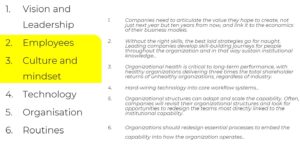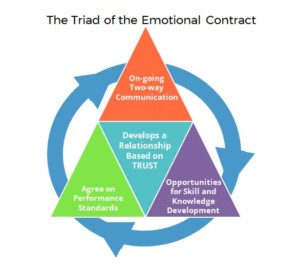The world needs good people managers. People with good people management and teambuilding skills.
A lot of what we focus on for team leader and manager roles is what might be referred to as the technical skill. Are they qualified in Finance, Systems Management, Service Delivery, Governance etc… In most cases these people are leading teams of people.
The technical expertise only goes as far as the content of what the team is working on.
These leaders of teams also need the people management skills to enable them to get the best out of the people within their team. To enable a high performing team.
It is these good people management skills we are looking at here.
All leaders of teams of people, need to have good people management skills.
Let’s dig into to why we need this.
Why be a good people manager
Let’s start with, why be a good people manager?
When this question is asked, we should hear things like:
- People and teams deliver the necessary services that are important with our customers and how they deliver that is important to us…
- People and Teams contribute to outcomes that are important to the organisation…
- People and Teams should be aligned to the broader organisational strategy – how we make progress towards the strategy depends on their engagement…
- People and Teams should be able to connect to our purpose and what we are trying to achieve in the world…
All great points and all very valid reasons to be a good people manager.
To ensure the teams and people we are responsible for are aligned and connected to our purpose. And engaged with us on that journey.
McKinsey Research
McKinsey Research from 2024, took a deep dive into what made the top seven (market favourites) organisations stand as a “superpower”. Their findings were that these organisations all had six elements that were key to their success. As shown below.

It may not seem like rocket science to list these six elements as the things we must get right in our businesses and organisations. In fact, I’m pretty sure most business schools would also list vision, leadership, organisation (structure etc), and systems and processes (routines, technology etc) as key elements to get right.

Employees and culture are two out of six key factors of success.
However, having the right people doing the right things with the optimal culture and mindset is the hard stuff. And, in my view, not talked about often enough.
The performance of two out of those six critical elements, are heavily influenced the manager, or team leader and “the people”.
Being a good people manager makes an incredible difference to culture, mindset, and performance of people and teams.
Having teams of good people managers separates excellent performing organisations from the rest.
The Key Point So Far
We all need good people managers.
Each manager of people and teams needs the conscious competence in the understanding, skills and techniques in being a good people manager.
* * *
“The relationship between managers and employees influences the working atmosphere as well as productivity. Discriminatory behaviour by managers results in a reduced work performance even if discrimination manifests only in the fact that the manager has less contact with certain employees.”
Behavioural Economics for Leaders, Matthias Sutter (2023, Wiley, page 66)
* * *
As W. Edwards Deming once said (paraphrased): gaining performance improvement from focusing on people is only part of the solution. Process and systems are another big part of gaining performance improvement…90-to-94% of performance improvement is gained from improving the systems and processes, not the people… We need our people to be working on the processes and systems that improve performance over time.
Being a “good people manager” is a key skill each team-leader and manager needs. Having teams of people engaged in their work and connecting this work to the objective and strategy is key to the ongoing success and sustainability of the organisation.
Let’s now dig in to what it takes to become a good people manager.
Firstly, we will look at the three “contracts” that exist between employees and their employer and manager. Then, dive deep into the emotional contract and the tools and techniques good people managers use.
The Three Contracts
When we consider how a person connects and identifies with their environment at work, we see that there are three ‘contracts’ in play.
Employment contract
The first is the actual employment contract that we sign with the organisation where we are employed. This contract spells our obligations to the organisation and the rights we have of being an employee here. The details of remuneration, leave entitlements etc. This first contract is the legal contact.
Psychological contract
The second contract is the psychological contract, how we feel about working for the organisation. When you meet someone socially, do you say where you work, or what you do, and avoid naming where you work. Are you proud to say where you work. Or are you reluctant to share where you work because you may not want to be associated with the public perception of the organisation…? How you feel about the entity you work for is the psychological contract. How do you feel about the place you work at…?
Emotional Contract
The Emotional Contract is the third, and perhaps the most important. Important particularly as we are focussing in on how to be a good people manager. The Emotional Contract is about the relationship between the team member and the team leader/manager.
Can you trust your team leader/manager. Do you have honest conversations about performance, what’s expected of you, how you might improve, how the team is performing, and how you can contribute to the team…? Or do you just talk about operational, day-to-day stuff, pleasantries, and maybe some half-baked KPIs etc. And perhaps only one or twice a year talk about performance, what’s expected and how you are going…?
Remember, people typically do not leave a job, or a business, they leave their manager. When that relationship is not working, people leave.
Or, they remain and become the disengaged and are not particularly productive, but passive team members (which Gallop describe as a $8-trillion problem worldwide).
It is the ongoing nature of the conversations and communications between the team leader-manager and the team member that establishes a foundation of trust over time.
* * *
“Trust is an economic asset. Lack of trust is expensive.”
Behavioural Economics for Leaders, Matthias Sutter (2023, Wiley)
* * *
The Triad of the Emotional Contract
Illustrated in the model below, is the Triad of the Emotional Contract between the team leader and the team member.
Trust is the centre point.
The relationship between team member and team leader needs to be based on TRUST.
This trust is derived from (principally) these three activities and behaviours.
- A conversation that creates a clear agreement between the two people of the standards of performance.
- Regular and ongoing two-way communication. And,
- A commitment from the team leader to provide opportunities for skill and knowledge development. Ongoing commitment from the team leader to support the team member in achieving their performance goals.

The regular (fortnightly, or three weekly) ongoing two-way communication sessions are delivered through regular one-on-ones to collaboratively discuss performance against the agreed standards and criteria.
These “catch-ups” can be done in 15-20 mins. The first session might be 30-45 mins. It is the regularity that is important. Combined with the commitment from the team leader that this is two-way communication. The team leader does not do all the talking.
Principles for establishing a foundation of trust
Below are the five guiding principles for how this is approach should be delivered. In other words, the five guiding principles for the Team Leader interacts with the team member. . (Zenger-Miller 1998).
- Focus on the situation, issue or behaviour, not on the person;
- Maintain the self-confidence and
self-esteem of others; - Maintain constructive relationships;
- Take the initiative to make things better; and
- Lead by example.
KPIs and “standards of performance”
When good people managers have a conversation with their team member about the standards of performance, these are not conversations that negotiate a set of activity based KPIs.
The conversations are about the displayed attitudes and behaviours. These conversations are about how people work together, share their insights and skills with other team members.
It is these conversations, along with the agreed standards of performance, that create and bring a team to higher levels of performance (as a team).
Using activity based KPIs drives self-rewarding behaviours rather than teams. Negotiating activity based KPIs with a team member makes them focus on their own numbers, compliance with those numbers, and not team outcomes. These types of KPIs drive individualistic behaviour, not team focused behaviours.
Here are a couple of additional articles on this subject:
The Eight Missed Opportunities for Employee Motivation
There is an alternate approach to this activity based KPIs. And, that is focusing teams on outcomes.
Focusing the team on outcomes and using their performance measures to see how close they can get to that outcome; inspires curiosity about how to improve. It switches from compliance with KPIs to using measurement to learn how to improve. Motivating as they feel a sense of progress towards the outcome.
Read more on this approach here:
The Eight Steps to a High Performance Organisation.
The Research and Theory that supports this approach.
The ‘pop-psychology of motivation’ says that specific and difficult goals lead to higher performance. This concept has led to the poor practice of setting KPIs that are meant to (magically) lift people’s performance to hit those targets.
However, goals need to be set collaboratively. Additionally, there are three factors affect the goals-performance relationship:
- goal commitment – the person’s acceptance and commitment to the goal;
- adequate self-efficacy – their belief in themselves that they can achieve the goal, and
- national culture. From the research I have seen there were only two cultures that responded to these difficult, challenging goals – Sales Teams based in the USA and Singaporean work teams
Converse to this, Alderfer’s ERG Theory, states, that the three core needs of Existence, Relatedness, Growth all coexist.
The ERG theory is a more valid version of a need hierarchy (Maslow), by allowing more than one need to be operating simultaneously. And this reminds us that team members have needs and motivational forces at three levels that relate to survival, personal relationships, and, personal growth and development. Which should be addressed using the Triad of the Emotional Contract (as described above).
How to Gain Change
Also, Team Leaders should be mindful that when we are trying to bring about a change in the Team Members behaviour (that can lead to improved performance). The focus needs to be aimed at the values and assumptions that drive the behaviour (see below image).
All too often Team Leaders attempt to “tell” team members to change certain behaviours. This does not work. We need understand what values and assumptions are driving the team members behaviours, and address those.

Teams
Good people managers also recognise that they are a leader and managing a team of individuals.
It is critical to know your team members. Not just the ones you like…
Each individual will have different and diverse:
- skills and abilities
- temperaments, behaviours
- beliefs, cultural norms
- values
Each team member will also adopt various roles within the team.
A team that functions together, can achieve more than the individuals (independently). The Team Leader as a “good people manager” will bring the best out in each individual to create a cohesive team.
Summing up: How to be a Good People Manager
A good people manager:
- Uses the five key principles for establishing a foundation of trust with the team member
- Uses these mindsets and approaches to understand and optimise the performance of each individual in their team
- Describes the outcomes the team is working towards (supported with performance measures)
- Has regular one-on-ones with each team member
And will therefore raise team cohesion and performance.
Also, (I believe this is useful) they become a student of, Neuroscience and Behavioural Economics. As studies into this area of human behaviour are proving to be quite insightful for people managers. Particularly, in breaking down some old stereotypes and false assumptions. For example: Thinking fast and Slow, Daniel Kahneman; Brain Rules, John Medina; Drive, Dan Pink; The Excellence Dividend, Tom Peters…
The Four Focus Areas for Managers
Coaching for Performance Toolkit and Processes
Provides a Toolkit and Supporting Processes. Good people managers develop their skills over time. Through the application of these principles and techniques we have discussed already, but also through the usage of specific processes and developing skills, particularly in communication.
In the approach I call, Coaching for Performance there are a set of step-by-step processes to help guide the team leader in developing their skills.
These processes are, firstly. How to agree and set standards of performance and then holding the regular one-on-one discussions. Supported by how to genuinely recognising achievements and the process of Taking Corrective Action meetings.
See more on this page, and in this blog post.
And the downloadable Coaching for Performance workbook in the shop.
Featyred Image by Annie Spratt on Unsplash



